Alleppey - Alappuzha - Venice of Kerala
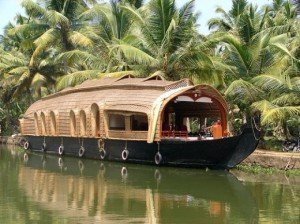
Alappuzha Backwaters
Alappuzha (pronounced in Malayalam), also known as Alleppey, is a popular tourism town in the State of Kerala in the southern part of India. This town is packed with picturesque canals, backwaters, beaches and lagoons which form the primary attraction for tourists worldwide. In the famous List of Important Places by Lord Curzon he described this area as the Venice of the East. Thereby it can be noted that the city of Alleppey has a wonderful past. Though the present town owes its existence to the sagacious Diwan Raja Kesavadas who ruled Kerala in the second half of 18th century, the district of Alappuzha figures in classical Literature. Kuttanad, the rice bowl of Kerala with the unending stretch of paddy fields, small streams and canals with lush green coconut palms, was well known even from the early periods of the Sangam age. History says Alappuzha had trade relations with ancient Greece and Rome in the early B.C and in the Middle Ages, as also with other parts of India
Alappuzha History
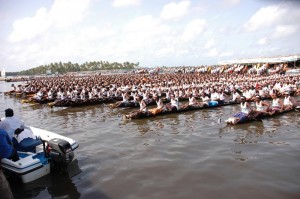
Alappuzha boating race
The history of the district in the Paleolithic age is obscure. It is presumed that the coastal taluks of Cherthala, Ambalapuzha and Karthikapally might have been under water and these areas were formed by the accumulation of silt and sand later than the other parts of the district. Kuttanadu, one of the taluks of the present Alappuzha district was well known even from the early periods of the Sangam age. The early Cheras had their home in Kuttanadu and they were called ' Kuttuvans ', named after this place. Christianity had a strong foothold in the area even from the Ist century A.D. The church located at Kokkomangalam or Kokkothamangalam in Cherthala is one of the seven churches founded by St. Thomas, one of the twelve disciples of Jesus at Maliankara in Muziris port, presently known as Cranganore of Kodungallur in 52 A.D. and preached Christianity in South India. During 9th to 12th century A.D, the district flourished in the field of religion and culture under the second Chera empire.
During the 16th century small principalities like Kayamkulam (presently Karthikappally and Mavelikkara taluks), Purakkad which was often called Ambalappuzha or Chempakasseri (present Ambalappuzha and part of Kuttanadu taluk) Karappuram comprising two principalities called Moothedath and Iledath (present Cherthala taluk) emerged into power.
In the same period, the Portuguese came into prominence in the political scene of this district and they built several churches of which churches located at Purakkad and Arthungal are wellknown.
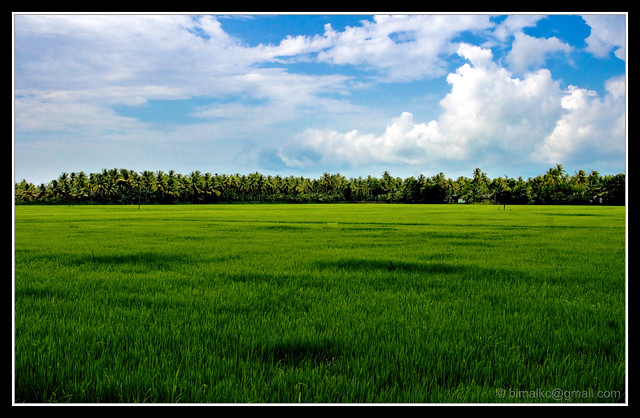 |
| Paddy Field Kuttanad aslleppey |
In the 17th century the Portuguese power declined and the Dutch had a predominant position in the principalities of this district. As a result of several treaties signed between the Dutch and the kings of Purakkad, Kayamkulam and Karappuram, the Dutch built factories and warehouses in various places of the district for storing pepper, ginger,etc.
In course of time they interfered in the political and cultural affairs of the district. It was at that time Maharaja Mathandavarma, the 'Master of Modern Travencore' interfered on the political affairs of those principalities.
The annexation of the kingdoms of Kayamkulam, Ambalappuzha, Thekkumkur, Vadakkumkur and Karappuram to Travancore gave the Dutch a set back from the political scene of the district. Marthandavarma Maharaja had a remarkable role in the internal progress of the district. He gave special attention to the development of Mavelikkara as an administrative as well as a commercial centre.The Krishnapuram palace, which is now a protected monument of the State Archaeology Department was constructed during that period.
When the town was founded by Raja Kesavadasan, the Diwan of Travancore in 1762, there was just one canal through the strip of sand between the backwaters and the sea. This soon grew into a bustling waterway, with shops, factories and commercial establishments springing up on either banks of the canal. This attracted merchants from other parts of the country.
By the mid 19th century the sea receded a mile offering more land along the sandstrip. Trading vessels soon began to call on Alappuzha. In 1859 the first organised coir factory was started here and began producing matting from coir yarn on a loom developed by an English Sea Captain. Soon other British owned weaving establishments followed .Meanwhile in 1816 the Church Missionary Society set up its local Headquarters in Alappuzha and three years later the first Anglican church was built. In 1851 Jalap had the honour of housing the first post office in the erstwhile Travancore State.
Before, Alappuzha was combined with Kottayam and Kollam but after 1957, Alappuzha became a separate district. It was in Alappuzha that the first post office and telegraph office of the Travancore was established. The role of Alappuzha in the Indian Independence is worth mentioning. In 1946, there was the struggle of Punnapra and Vayalar. It was against the Diwan of Travancore which led to his withdrawal from the politics.
Places to Visit
Kuttanad:
Kuttanad, called the 'Rice Bowl of Kerala' because of its wealth of paddy crops, is at the very heart of the backwaters. The scenic countryside of Kuttanad with its shimmering waterways also has a rich crop of banana, cassava and yam. This is perhaps the only region in the world where farming is done 1.5 to 2 m below sea level. lnland waterways which Row above land level are an amazing feature of this region.
Alappuzha Beach:
Kuttanad:
Kuttanad, called the 'Rice Bowl of Kerala' because of its wealth of paddy crops, is at the very heart of the backwaters. The scenic countryside of Kuttanad with its shimmering waterways also has a rich crop of banana, cassava and yam. This is perhaps the only region in the world where farming is done 1.5 to 2 m below sea level. lnland waterways which Row above land level are an amazing feature of this region.
Alappuzha Beach:
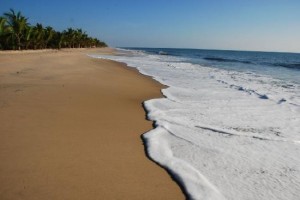
Alappuzha Beach
This is one of the most popular picnic spots in Alappuzha. The pier here, which extends into the sea, is over 137 years old. Entertainment facilities at the VijayaBeachPark add to the attractions of the beach. There is also an old lighthouse which is greatly fascinating to visitors.
The Vijaya Beach Park:
(Open 1500 -2000 hrs) Picnic spot with children's park & boating facilities. Entrance Fee: Rs. 2 per person; Free entrance for children below 5 years. Boating charge: Rs. 10 for 10 minutes. Other facilities for children: Toy train, bicycles. Video permit: Rs. 25, Camera permit: Rs.5 respectively.
Alappuzha Canal:
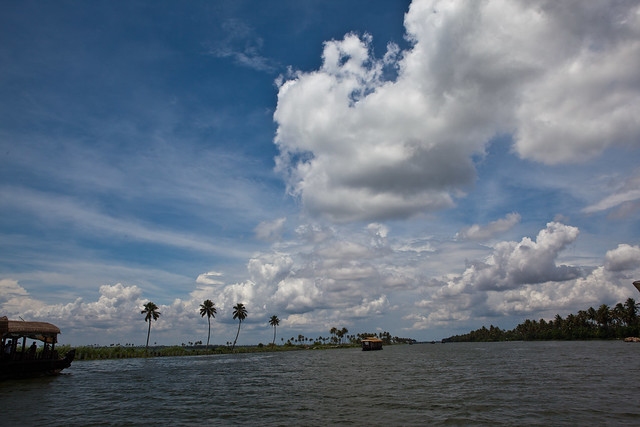
The vast network of canals and its promenades lined with eateries, shops selling ethnic artefacts and so on are a major tourist attraction.
Sea View Park:
The park offers boating facilities and a swimming pool. Boat rentals for 10 minutes: • Round boat (4 seater): Rs. 10 • Pedal boat (2 seater): Rs, 15 • Pedal boat (4 seater): Rs. 25 • Video permit: Rs. 15 • Camera permit: Rs, 100 respectively.
Pathiramanal:
(1 1/2hrs by motorboat/30 min. by speedboat from Alappuzha) According to mythology a young brahmin dived into the vernbanadLake to perform his evening ablutions and the water made way for land to rise from below, thus creating the enchanting island ofPathiramanal (sands of midnight).
Chakkulathukavu Bhagavathy Temple:
(30 km southeast oj'Alappuzba near Neereuupuram. Open 0500 -1300 brs, 1630-2000 brs) Situated on the border of Pathanamthitta and Alappuzha districts, the famous rivers Pamba and Manimala flow on either side of the temple. Ph: 0477-2213550
Champakulam Church:
Among the oldest churches in Kerala, the St. Mary's Church is believed to be one of the seven established by St. Thomas in AD 427. The annual feast of this church falls on the 3rd Sunday of October every year. The feast of St. Joseph is celebrated on March 19th. Nearby is a place that makes wooden statues of Christ for export around the world.
Q, S, T and R Block Kayal:
These regions are wonders of the indigenous agricultural engineering know-how of Kerala and remind the visitor of the famous dikes of Holland. Extensive areas of land have been reclaimed from the backwaters and are protected by dikes built all around, a process that started 100 years ago. Here, cultivation and habitation are made possible four to ten feet below sea level. R Block, at nearly 850 acres, is the largest reclaimed area. A leisurely cruise along the canals that surround these kayals is a memorable experience.
Chavara Bhavan:
(6 km from Alappuzha. Accessible only by boat) Chavara Bhavan is the ancestral home of the blessed Kuriakose Elias Chavara. It is now a holy shrine and spiritual resort where thousands of devotees gather for prayers and receive favours. Here, a 250-year-old historically important beacon of light is preserved intact in its original and primitive form that continues to burn even today.
Ambalappuzha Sree Krishna Temple:
(15 km from south of Alappuzha) Built in the typical Kerala architectural style, this temple is famous all over India for the Palpayasam, the daily offering of deliciously sweet milk porridge. It is also in this temple that Pallipana is performed by velans (sorcerers) once in every twelve years. Paintings of the Dasavatharam (the ten incarnations of Lord Vishnu) are on display on the inner walls of the Chuttambalam. Ottanthullal, a satiric art form created by the poet Kunchan Narnbiar, was first performed on the premises of this temple.
Arthunkal Church:
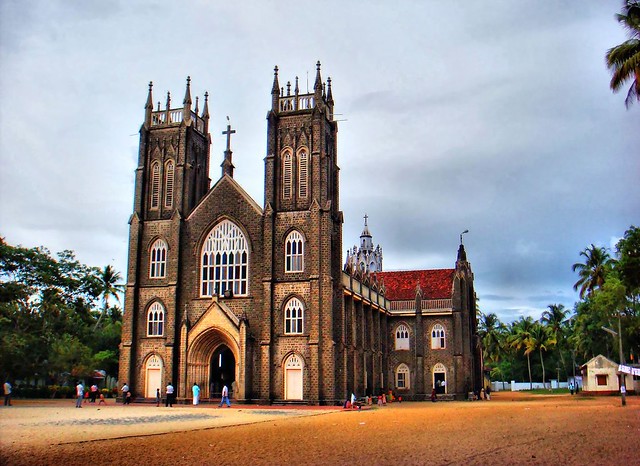 |
| rthunkal Church Alleppey |
(22km north of Alappuzha) The St. Sebastian's Church here is an important Christian pilgrim centre. The annual festival, Arthunkal Perunnal is celebrated in january,
Edathua Church:
(24km/romAlappuzha, on the Alappuzha - Thiruvalla Road). Open 04:00-20:00 brs, Prayer timings: 06:00 and 07:00 hrs -Fridays 1600brs as well, Sundays
06:00,08:00, 10:00 and 16:00 hrs) Established in 1810, the church is dedicated to St. George. Ph: 0477-2212234
Thakazhi Museum and Smritimandapam:
(22 km from Alappuzha. Open 09:30 – 16:30 brs except on Mondays) This museum-cum-memorial hall is dedicated to the memory of the late Thakazhi Sivasankaran Pillai (1912-1999), the famous writer who won the] nanpeeth award in 1984, and whose writings include 35 novels and 600 short stories. Ph: 0479-2274243
Mannarasala Sree Nagaraja Temple:
(32 hm south of Alappuzha) Situated near Harippacl, this is a serpent shrine under the patronage of a Brahmin tamily headed by a priestess. The ancient shrine is an internationally renowned pilgrim centre dedicated to the Serpent God Nagaraja. Sarpa Yakshi and Naga Yaksbi are the beloved consorts of Nagaraja. It is believed that Nagaraja, as the installed deity, is endowed with the form of Hari (Lord Vishnu) and the spirit of Lord Shiva. Legend has it that the first priestess of Mannarasala gave birth to a fiveheaded snake, which is believed to reside in the ancestral house to safeguard the family. At Mannarasala, barren women are believed to be blessed with children and a special turmeric paste available at the shrine is credited with powers to cure even leprosy.
Chettikulangara Bhagavathy Temple, Mavelikkara:
The Kettukazhcha Festival at this temple draws large crowds of devotees. Processions of tall decorated structures on chariots, brightly decorated effigies of horses and bullocks and cultural performances make a spectacular pageant. (Festival- Februarylstarcb}. The one-day annual Bharani festival at the temple is also a popular event. In front of the sanctum sanctorum is the 11f t-high, 13-tiered stone lamp capable of holding a thousand wicks, said to be the largest and most elaborate lamp in India.
Krishnapuram Palace:
Edathua Church:
(24km/romAlappuzha, on the Alappuzha - Thiruvalla Road). Open 04:00-20:00 brs, Prayer timings: 06:00 and 07:00 hrs -Fridays 1600brs as well, Sundays
06:00,08:00, 10:00 and 16:00 hrs) Established in 1810, the church is dedicated to St. George. Ph: 0477-2212234
Thakazhi Museum and Smritimandapam:
(22 km from Alappuzha. Open 09:30 – 16:30 brs except on Mondays) This museum-cum-memorial hall is dedicated to the memory of the late Thakazhi Sivasankaran Pillai (1912-1999), the famous writer who won the] nanpeeth award in 1984, and whose writings include 35 novels and 600 short stories. Ph: 0479-2274243
Mannarasala Sree Nagaraja Temple:
(32 hm south of Alappuzha) Situated near Harippacl, this is a serpent shrine under the patronage of a Brahmin tamily headed by a priestess. The ancient shrine is an internationally renowned pilgrim centre dedicated to the Serpent God Nagaraja. Sarpa Yakshi and Naga Yaksbi are the beloved consorts of Nagaraja. It is believed that Nagaraja, as the installed deity, is endowed with the form of Hari (Lord Vishnu) and the spirit of Lord Shiva. Legend has it that the first priestess of Mannarasala gave birth to a fiveheaded snake, which is believed to reside in the ancestral house to safeguard the family. At Mannarasala, barren women are believed to be blessed with children and a special turmeric paste available at the shrine is credited with powers to cure even leprosy.
Chettikulangara Bhagavathy Temple, Mavelikkara:
The Kettukazhcha Festival at this temple draws large crowds of devotees. Processions of tall decorated structures on chariots, brightly decorated effigies of horses and bullocks and cultural performances make a spectacular pageant. (Festival- Februarylstarcb}. The one-day annual Bharani festival at the temple is also a popular event. In front of the sanctum sanctorum is the 11f t-high, 13-tiered stone lamp capable of holding a thousand wicks, said to be the largest and most elaborate lamp in India.
Krishnapuram Palace:
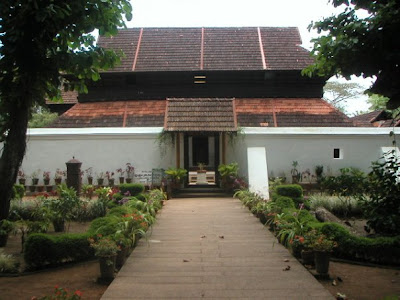 |
| Krishnapuram Palace alapuzha |
(47 km from Alappuzha) Built by Marthanda Varma, this palace at Karrhikapally in Kayamkulam is famous for its three-metre high mural depicting the story of Gajendramoksham. Dating back to the 18th century, this exquisite piece of art is one of the largest murals in Kerala, The palace which is a museum now, houses antique sculptures, paintings and bronze artefacts.
Karumadi Kuttan:
(3 km east of Ambalapuzha) Many fascinating legends are associated with this 11th century statue of Lord Buddha, protected by the State Archaeological Department. The locals regard the Kuttan with affection and he is credited with many healing powers.
Karumadi Kuttan:
(3 km east of Ambalapuzha) Many fascinating legends are associated with this 11th century statue of Lord Buddha, protected by the State Archaeological Department. The locals regard the Kuttan with affection and he is credited with many healing powers.
No comments:
Post a Comment